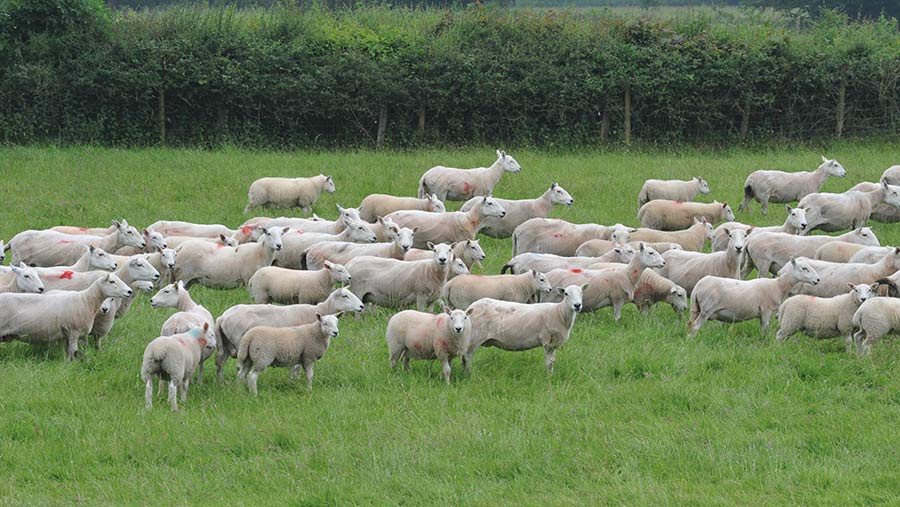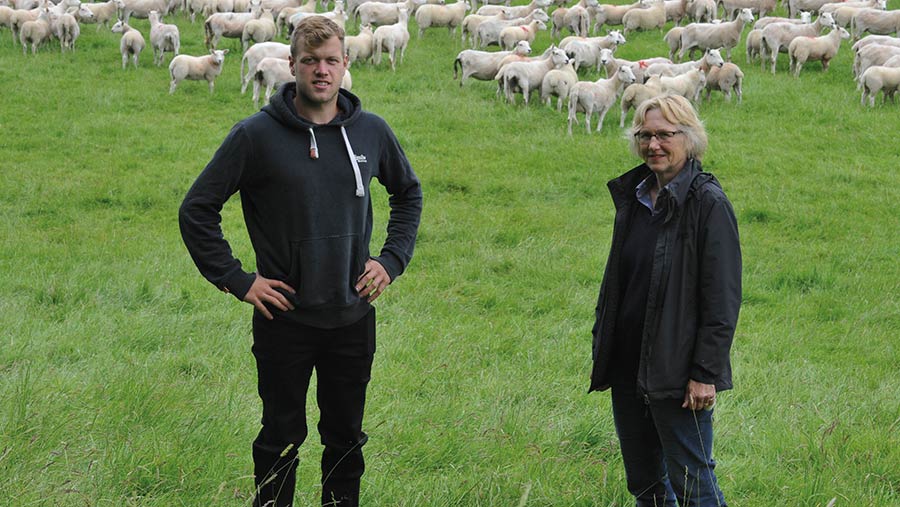What a Carmarthenshire farm did to lift profits by 52% a ewe
 Aberfield and Welsh ewes at Glanmynys © Debbie James
Aberfield and Welsh ewes at Glanmynys © Debbie James Monitoring ewes and managing their body condition score (BCS) has helped reduce the rate of barren and aborted ewes by 6.4% in a Welsh flock, helping to lift profit margin by £3.34 a ewe to £9.65.
Farm owner Carine Kidd and share farmer Peredur Owen run a flock of mostly Easycare ewes alongside a beef rearing system at Glanmynys, a 215ha (531-acre) Farming Connect demonstration farm near Llandovery in Carmarthenshire.
See also: Tips for feeding and managing ewes for lambing success
Through their work with Farming Connect, they have worked with industry experts, including independent sheep specialist Lesley Stubbings, to improve performance in their flock of 1,000 breeding ewes and 300 ewe lambs.
Management changes have included transitioning the flock to the Easycare breed, introducing outdoor lambing, reseeding, and growing more forage and winter crops.

Share farmer Peredur Owen and farm owner Carine Kidd © Debbie James
The resulting move away from concentrates has reduced annual feed costs by £1.52 a ewe.
Monitoring flock performance, including condition-scoring ewes at key stages, has been fundamental to improved profitability.
Farm facts
- 215ha (531 acres) Farming Connect demonstration farm
- 1,000 Easycare, Aberfield and Welsh ewes, and 300 ewe lambs
- 250 Angus and Wagyu cattle reared on contract
- 6ha (15 acres) swedes for outwintering
- 31ha (77 acres) woodland
Management tool
Ms Stubbings advised farmers that condition-scoring ewes was a simple and effective management tool for evaluating the body reserves of ewes pre-tupping, at scanning and at weaning.
This process has become even more of a priority this summer because grazing has come under pressure from extreme dry weather. By intervening now, Ms Stubbings said, dry matter (DM) covers could be matched to flock performance and farmers could make informed decisions.
“BCS is the one key performance indicator (KPI) that everyone can monitor – it has an over-riding effect on all the other performance factors,” she said.
“If you want a ewe to perform, you must keep her at the right BCS throughout the year.”
A target that every flock can achieve is to get the right level of condition at mating in at least 90% of the flock – for lowland breeds, this means a condition score of 3-3.5, and in hill breeds, 2.5-3.
As a result of achieving target BCS, in combination with improved nutrition, scanning percentage in the flock at Glanmynys has increased by 9%.
Planning for drier summers
To manage ewe condition during a summer of poor grass growth, leaner ewes from the Glanmynys flock have been sent away to graze land with higher covers, while a system of daily moves is in place for the fitter ewes.
A programme of reseeding has seen the introduction of multispecies leys at Glanmynys (see “Advice on preparation for reseeding”). The aim is for them to future-proof the farm against drier summers.
They have also helped with lamb performance post-weaning. “The clear advantage was the growth through the drought conditions of summer, which allowed us to wean lambs earlier,” said Mr Owen.
A 15-acre crop of swedes has also been planted for grazing from mid-December to the end of February. Ewes will then be turned onto grass from 1 March, ahead of lambing from 1 April.
Increased profit
Veterinary and medicine costs have doubled in the past three years because the business has invested in metabolic profiling and blood sampling to evaluate trace element levels and is also vaccinating to prevent flock lameness.
However, thanks to improved efficiency and a shift towards a low-input, forage-based system, profit margin a ewe has increased by 52% from £6.31 to £9.65.
Early intervention needed for thinner ewes
With grass in short supply this year, there is likely to be a higher percentage of thinner ewes than normal.
Therefore, early intervention is key, because it takes 6-8 weeks to lift fat cover by one condition score.
A single condition score is between 10-13% of bodyweight. In a 70kg ewe, that amounts to 8-9kg. Therefore, if a ewe is at BCS 2 and needs to be lifted to BCS 3.5, she needs to put on 13kg.
That is an additional 10MJ/day above maintenance requirements for 10 weeks – almost the same as a pre-lambing diet, says independent sheep specialist Lesley Stubbings.
“This means a high level of feeding for lean ewes with concentrate supplementation as well as hay or silage when grass is short.”
Hands-on assessment
Ms Stubbings advises farmers to physically feel ewes for condition and not rely on a visual assessment.
This can be done by handling them in the lumbar region, immediately behind the last rib. The amount of eye muscle and degree of fat cover over the spinous and transverse processes should be assessed.
Advice on preparation for reseeding
Farmers are being urged to review how they apply herbicides for sward destruction because too many are using them incorrectly, according to one industry expert.
Francis Dunne of Field Options says a common mistake farmers make is to apply glyphosate when there is insufficient leaf area.
“A lot of farmers use glyphosate inefficiently,” said Mr Dunne, a speaker at the Farming Connect event at Glanmynys. “If there is not enough leaf area, the sward will not be able to take up sufficient product to kill it off.”
A grass cover of around 2,500kg dry matter (DM)/ha is advised to provide the ideal conditions for uptake.
Optimum conditions
Mr Dunne advises a 12-month lead-in time when planning for reseeds to ensure conditions are at an optimum for sowing.
That preparation should include soil sampling to allow for any necessary corrections to be made to nutrient status, and planning herbicide applications to deal with perennial weeds prior to final sward destruction.
He recommends growing a break crop ahead of a grass reseed. “A grass-to-grass reseed is less reliable, particularly in dry conditions, because of the turfs and the pests associated with old pasture,” he said.
A break crop of swedes is being grown on 6ha (15 acres) at Glanmynys; this will provide winter forage for pregnant ewes.
Soil-to-seed contact
Mr Dunne said another focus in the reseeding programme should be good seed-to-soil contact.
While multiple machinery options are available to make sowing grass easier and faster, the result can be less effective because the seed is in poor contact with the soil.
“You make a lot of your own luck with sowing seed,” he said.
“It is a very expensive process, and it is worth remembering that an effective reseed lasts for years, but a poor one will need replacing within two or three years because it won’t be performing.”
Weed control
Prompt action is recommended for dealing with weeds in young reseeds. “Many farmers don’t think about weed control until the weeds are too far ahead and control is less effective,” he warned.
Four to five weeks after sowing is usually when weed seedlings are at their most susceptible to selective herbicides, should intervention be needed.
However, as herbicides were not effective for use on very diverse swards, Mr Dunne said conventional farmers needed to be sure of controlling weeds ahead of sowing, and possibly also using stale seed-bed techniques.
